Post-Wildfire Debris Flow and Large Woody Debris Transport Modeling from the North Complex Fire to Lake Oroville
Abstract
:1. Introduction
2. Study Area and Methods
2.1. Study Area
2.2. Watershed Selection
2.3. Mapping of LWD
2.4. Debris Flow Modeling
2.5. LWD Transport Modeling
- ID: Unique identifier for each LWD as a sequential integer.
- Watershed: The name of the watershed where the LWD originates.
- Xcoord and Ycoord: The initial x- and y-coordinate of the LWD in the debris flow fan areas.
- DBH: The diameter of the LWD piece at breast height.
- Status: Status of the tree, which is classified as 1 = rooted, 2 = lying, 3 = moving, 4 = jammed. The initial status of living wood is always 1 and that of dead wood is 2.
- Rootwad: The diameter of Rootwad of the LWD piece.
- Length: The length of the LWD piece.
- Structure: The wood structure for a standing tree.
- Slope: The geomorphologic characteristics of the areas for the LWD of piece.
3. Results
3.1. LWD Transport via Debris Flows
3.2. LWD Transport and Fate along the MF of Feather River and into Lake Oroville
3.3. Comparison to Previous LWD Removals from Lake Oroville
4. Discussion
- Debris flow fan development was impacted by the lack of LiDAR data in the channel of the MF Feather River. The faceted DEM at this location had an impact of debris flow formation and these represent a best approximation of the surficial feature at these locations.
- There were heavily burned standing trees along the channels that were not incorporated into the counts of LWD. These could become a potential source of LWD as they fall into channels through the undercutting of the stream bank, wind throw, or as the trees decompose over time. These will continue to provide a supply of LWD to the system over time.
- There were locations along the watershed valley bottoms where LWD sampling was inhibited by “noisy” LiDAR data associated with dense lower canopy vegetation and in some instances these areas were in shadows within the imagery because of the time of day the aerial photographs were taken. In both instances, the LWD population through these areas was likely underrepresented.
- We assumed entrained LWD in our modeling approach made it out of the medium and small watersheds to the MF Feather River. This was a limitation in the approach, as we were unable to account for terrain conditions where the LWD might have been trapped behind large rocks or jammed behind trees and between the banks. This could lead to an overestimation of the amount of LWD from the ground that would be transported to the MF Feather River. However, even with this limitation, we were likely underestimating the total magnitude of LWD because the burned standing trees are not accounted for in this measurement.
- The hydrodynamics were derived using the 2D HEC-RAS model, where the following limitations for the application to the hydrodynamic transport of LWD were identified:
- The hydrodynamic was resolved at the resolution of the bathymetry data.
- The hydrodynamic model lacked validation due to limited data although the best practices were followed for model setup, parameterization, etc.
- The influence of wind on the surface velocity was not included in the hydrodynamic model where the resulting surface flow can change the path of the LWD within Lake Oroville.
- The hydrodynamic was unilaterally coupled with the transport model such that the influence of the LWD on the hydrodynamics is not accounted for. This may have resulted in poor results where the river channels were jammed by LWD.
- The hydrodynamic transport of LWD was a very complex process involving LWD recruitment due to the hydro-dynamic, entrainment, transport, and deposition of LWD, and obstruction of LWD.
- The initial LWD position was randomly distributed within the main trunk of the river, which requires further investigation via field survey.
- The hydrodynamic recruitment process was based on a probabilistic approach rather than a physical based solution, although this does not apply to this study, as all LWD applied in this analysis were recruited from the hillside due to a landslide.
- The length or dimension of the tree is not directly modeled, which means:
- a.
- Interactions between trees, with large rocks on the stream bed, and logs breaking were not accounted for in this model.
- b.
- Limitations are at the narrow section of the river when the river width was on the same order of LWD length or less. Attempts have been made to account for this empirically by adjusting the estimated transport rate, removing the LWD that have the lengths longer than the restricted cross section width downstream from their origin.
- c.
- Underestimation may also be caused by neglecting other processes such as sediment transport and morphology changes during the flood event.
5. Conclusions
Author Contributions
Funding
Data Availability Statement
Acknowledgments
Conflicts of Interest
References
- Zelt, R.B.; Wohl, E.E. Channel and woody debris characteristics in adjacent burned and unburned watersheds a decade after wildfire, Park County, Wyoming. Geomorphology 2004, 57, 217–233. [Google Scholar] [CrossRef]
- Short, L.E.; Gabet, E.J.; Hoffman, D.F. The role of large woody debris in modulating the dispersal of a post-fire sediment pulse. Geomorphology 2015, 246, 351–358. [Google Scholar] [CrossRef]
- Seo, J.I.; Nakamura, F.; Nakano, D.; Ichiyanagi, H.; Chun, K.W. Factors controlling the fluvial export of large woody debris, and its contribution to organic carbon budgets at watershed scales. Water Resour. Res. 2008, 44, W04428. [Google Scholar]
- Ruiz-Villanueva, V.; Gibaja, J.; Piégay, H. Instream large wood at the Génissiat dam reservoir: From problems to opportunities. In Proceedings of the 39th IAHR World Congress, Granada, Spain, 19–24 June 2022; pp. 2730–2734. [Google Scholar] [CrossRef]
- Iskin, E.P.; Wohl, E. Wildfire and the patterns of floodplain large wood on the Merced River, Yosemite National Park, CA, USA. Geomorphology 2021, 389, 107805. [Google Scholar] [CrossRef]
- Berg, N.; Azuma, D.; Carlson, A. Effects ofwildfire on in-channelwoody debris in the Eastern Sierra Nevada, California. In Proceedings of the Symposium on the Ecologyand Management of Dead Wood in Western Forests, Reno, NV, USA, 2–4 November 1999; USDA Forest Service: Asheville, NC, USA, 1999. [Google Scholar]
- Wohl, E.; Marshall, A.E.; Scamardo, J.; White, D.; Morrison, R.R. Biogeomorphic influences on river corridor resilience to wildfire disturbances in a mountain stream of the Southern Rockies, USA. Sci. Total Environ. 2022, 820, 153321. [Google Scholar] [CrossRef]
- Chen, X.; Wei, X.; Scherer, R. Influence of wildfire and harvest on biomass, carbon pool, and decomposition of large woody debris in forested streams of southern interior British Columbia. For. Ecol. Manag. 2005, 208, 101–114. [Google Scholar] [CrossRef]
- Marcus, W.A.; Rasmussen, J.; Fonstad, M.A. Response of the Fluvial Wood System to Fire and Floods in Northern Yellowstone. Ann. Assoc. Am. Geogr. 2011, 101, 21–44. [Google Scholar] [CrossRef]
- Shakesby, R.; Doerr, S. Wildfire as a hydrological and geomorphological agent. Earth-Sci. Rev. 2006, 74, 269–307. [Google Scholar] [CrossRef]
- Kean, J.W.; Staley, D.M. Forecasting the Frequency and Magnitude of Postfire Debris Flows Across Southern California. Earth’s Futur. 2021, 9, e2020EF001735. [Google Scholar] [CrossRef]
- Booth, A.M.; Sifford, C.; Vascik, B.; Siebert, C.; Buma, B. Large wood inhibits debris flow runout in forested southeast Alaska. Earth Surf. Process. Landf. 2020, 45, 1555–1568. [Google Scholar] [CrossRef]
- Yamazaki, Y.; Egashira, S. Run Out Processes of Sediment and Woody Debris Resulting from Landslides and Debris Flow. In Proceedings of the 7th International Conference on Debris-Flow Hazards Mitigation, Golden, CO, USA, 10–13 June 2019; Special Publication 28. Association of Environmental and Engineering Geologists: Sacramento, CA, USA, 2019. [Google Scholar]
- Rusyda, M.I.; Ikematsu, S.; Hashimoto, H. Woody debris production and deopsition during flood at extreme rainfall period 2012-2013 in Yabe and Tsuwano River Basin, Japan. Indones. J. Geogr. 2020, 52, 290–305. [Google Scholar] [CrossRef]
- Benda, L.; Bigelow, P. On the patterns and processes of wood in northern California streams. Geomorphology 2014, 209, 79–97. [Google Scholar] [CrossRef]
- Wester, T.; Wasklewicz, T.; Staley, D. Functional and structural connectivity within a recently burned drainage basin. Geomorphology 2014, 206, 362–373. [Google Scholar] [CrossRef]
- Comiti, F.; Lucía, A.; Rickenmann, D. Large wood recruitment and transport during large floods: A review. Geomorphology 2016, 269, 23–39. [Google Scholar] [CrossRef]
- Kang, T.; Kimura, I.; Onda, S. Application of computational modeling for large wood dynamics with collisions on moveable channel beds. Adv. Water Resour. 2021, 152, 103912. [Google Scholar] [CrossRef]
- Ruiz-Villanueva, V.; Wyżga, B.; Zawiejska, J.; Hajdukiewicz, M.; Stoffel, M. Factors controlling large-wood transport in a mountain river. Geomorphology 2016, 272, 21–31. [Google Scholar] [CrossRef]
- Ruiz-Villanueva, V.; Gamberini, C.; Bladé, E.; Stoffel, M.; Bertoldi, W. Numerical modeling of instream wood transport, deposition, and accumulation in braided morphologies under unsteady conditions: Sensitivity and high-resolution quantitative model validation. Water Resour. Res. 2020, 56, e2019WR026221. [Google Scholar] [CrossRef]
- Kang, T.; Kimura, I.; Shimizu, Y. Numerical simulation of large wood deposition patterns and responses of bed morphology in a braided river using large wood dynamics model. Earth Surf. Process. Landf. 2020, 45, 962–977. [Google Scholar] [CrossRef]
- Persi, E.; Petaccia, G.; Fenocchi, A.; Manenti, S.; Ghilardi, P.; Sibilla, S. Hydrodynamic coefficients of yawed cylinders in open-channel flow. Flow Meas. Instrum. 2019, 65, 288–296. [Google Scholar] [CrossRef]
- Zischg, A.P.; Galatioto, N.; Deplazes, S.; Weingartner, R.; Mazzorana, B. Modelling spatiotemporal dynamics of large wood recruitment, transport, and deposition at the river reach scale during extreme floods. Water 2018, 10, 1134. [Google Scholar] [CrossRef]
- Rickenmann, D.; Laigle, D.M.B.W.; McArdell, B.W.; Hübl, J. Comparison of 2D debris-flow simulation models with field events. Comput. Geosci. 2006, 10, 241–264. [Google Scholar] [CrossRef] [Green Version]
- McDougall, S. Canadian Geotechnical Colloquium: Landslide runout analysis—Current practice and challenges. Can. Geotech. J. 2017, 54, 605–620. [Google Scholar] [CrossRef] [Green Version]
- Guthrie, R.; Befus, A. DebrisFlow Predictor: An agent-based runout program for shallow landslides. Nat. Hazards Earth Syst. Sci. 2021, 21, 1029–1049. [Google Scholar] [CrossRef]
- Barnhart, K.R.; Jones, R.P.; George, D.L.; McArdell, B.W.; Rengers, F.K.; Staley, D.M.; Kean, J.W. Muti-Model Comparison of Computed Debris Flow Runout for the 9 January 2018 Montecito, California Post-Wildfire Event. J. Geophys. Res. Earth Surf. 2021, 126, e2021JF006245. [Google Scholar] [CrossRef]
- Floyd, I.E.; Sanchez, A.; Gibson, S.; Savant, G. A modular, non-Newtonian, model, library framework (DebrisLib) for post-wildfire flood risk management. Hydrol. Earth Syst. Sci. Discuss. 2020, 1–21. [Google Scholar]
- Wasklewicz, T.; Guthrie, R.H.; Eickenberg, P.; Kramka, B. Lessons learned from the local calibration of a debris flow model and importance to a geohazard assessment. In Proceedings of the Geohazards 8 Conference Proceedings, Quebec City, QC, Canada, 12 June 2022; pp. 333–337. [Google Scholar]
- Wasklewicz, T.; Guthrie, R.H.; Eickenberg, P.; Kramka, B. Modeling Post-wildfire Debris Flow Erosion for Hazard. Environ. Connect. 2022, 22–24. [Google Scholar]
- Murphy, B.P.; Czuba, J.; Belmont, P. Post-wildfire sediment cascades: A modeling framework linking debris flow generation and network-scale sediment routing. Earth Surf. Process. Landf. 2019, 44, 2126–2140. [Google Scholar] [CrossRef]
- Wakabayashi, J.; Sawyer, T.L. Stream Incision, Tectonics, Uplift, and Evolution of Topography of the Sierra Nevada, California. J. Geol. 2001, 109, 539–562. [Google Scholar] [CrossRef] [Green Version]
- Stock, G.M.; Anderson, R.S.; Finkel, R.C. Pace of landscape evolution in the Sierra Nevada, California, revealed by cosmogenic dating of cave sediments. Geology 2004, 32, 193–196. [Google Scholar] [CrossRef] [Green Version]
- Brunsden, D. A critical assessment of the sensitivity concept in geomorphology. CATENA 2001, 42, 99–123. [Google Scholar] [CrossRef]
- Attal, M.; Mudd, S.M.; Hurst, M.D.; Weinman, B.; Yoo, K.; Naylor, M. Impact of change in erosion rate and landscape steepness on hillslope and fluvial sediments grain size in the Feather River basin (Sierra Nevada, California). Earth Surf. Dyn. 2015, 3, 201–222. [Google Scholar] [CrossRef] [Green Version]
- Riebe, C.S.; Kirchner, J.W.; Granger, D.E.; Finkel, R.C. Erosional equilibrium and disequilibrium in the Sierra Nevada, inferred from cosmogenic Al-26 and Be-10 in alluvial sediment. Geology 2000, 28, 803–806. [Google Scholar] [CrossRef]
- Staley Dennis, M.; Kean Jason, W. North Complex Fire—Preliminary Hazard Assessment; USGS Landslide Hazards Program: Golden, CO, USA, 2020. [Google Scholar]
- US Geological Survey. Emergency Assessment of Post-Fire Debris-Flow Hazards; USGS Landslide Hazard Program: Reston, VA, USA, 2022. Available online: https://landslides.usgs.gov/hazards/postfire_debrisflow/detail.php?objectid=327 (accessed on 7 February 2023).
- Guthrie, R.H.; Deadman, P.J.; Cabrera, A.R.; Evans, S.G. Exploring the magnitude–frequency distribution: A cellular automata model for landslides. Landslides 2008, 5, 151–159. [Google Scholar] [CrossRef]
- Arghya, A.B.; Hawlader, B.; Guthrie, R.H. A Comparison of Two Runout Programs for Debris Flow Assessment at the Alps Regions of Switzerland; Geohazards 8; Canadian Geotechnical Society: Quebec City, QC, Canada, 2022; pp. 325–331. [Google Scholar]
- Horton, P. Regional Hazard Assessments. Section 5.2. In Advances in Debris-Flow Science and Practice; Jakob, M., McDougall, S., Santi, P., Eds.; 2023; Available online: https://datahub.hku.hk/articles/chapter/_Advances_in_Design_for_Advances_in_Debris-Flow_Science_and_Practice/21399444 (accessed on 17 November 2022).
- Staley, D.M.; Negri, J.A.; Kean, J.W.; Laber, J.L.; Tillery, A.C.; Youberg, A.M. Updated logistic Regression Equations for the Calculation of Post-Fire Debris-Flow Likelihood in the Western United States; U.S. Geological Survey Open-File Report; U.S. Geological Survey: Reston, VA, USA, 2016. [CrossRef] [Green Version]
- Staley, D.M.; Negri, J.A.; Kean, J.W.; Laber, J.L.; Tillery, A.C.; Youberg, A.M. Prediction of spatially explicit rainfall intensity–duration thresholds for post-fire debris-flow generation in the western United States. Geomorphology 2017, 278, 149–162. [Google Scholar] [CrossRef]
- Guthrie, R.; Hockin, A.; Colquhoun, L.; Nagy, T.; Evans, S.; Ayles, C. An examination of controls on debris flow mobility: Evidence from coastal British Columbia. Geomorphology 2010, 114, 601–613. [Google Scholar] [CrossRef]
- Abbe, T.B.; Montgomery, D.R. Large woody debris jams, channel hydraulics and habitat formation in large rivers. Regul. Rivers Res. Manag. 1996, 12, 201–221. [Google Scholar] [CrossRef]
- Kramer, N.; Wahl, E. Rules of the road: A qualitative and quantitative synthesis of large wood transport through draiange networks. Geomorphology 2017, 279, 74–97. [Google Scholar] [CrossRef]
- Reeves, G.H.; Burnett, K.M.; McGarry, E.V. Sources of large wood in the main stem of a fourth-order watershed in coastal Oregon. Can. J. For. Res. 2003, 33, 1363–1370. [Google Scholar] [CrossRef]
- USACE. HEC_RAS River Analysis System: User’s Manual; Version 5.0, s.l.; Hydrologic Engineering Center: Davis, CA, USA, 2016.
- HDR. Frenchman Dam and Critical Appurtenant Structures: Hypothetical Failure Inundation Analysis and Maps; S.N.: Folsom, CA, USA, 2019. [Google Scholar]
- Galatioto, N. Modellierung der Schwemmholzdynamik Hochwasser-Fuhrender Fliessgewasser. Masters Thesis, University of Berne, Berne, Switzerland, 2016. [Google Scholar]
- Mazorana, R. Woody Debris Recruitment Prediction Methods and Transport Analysis; University of Natural Resources and Applied Life Science: Vienne, Austria, 2009. [Google Scholar]
- Lucía, A.; Comiti, F.; Borga, M.; Cavalli, M.; Marchi, L. Dynamics of large wood during a flash flood in two mountain catchments. Nat. Hazards Earth Syst. Sci. 2015, 15, 1741–1755. [Google Scholar] [CrossRef]
- Hardy, C.C. Guidelines for Estimating Volume of Biomass and Smoke Production for Piled Slash—General Technical Report PNW-GTR-364; Department of Agriculture, Forest Service, Pacific Northwest Research Station: Portland, OR, USA, 1996.
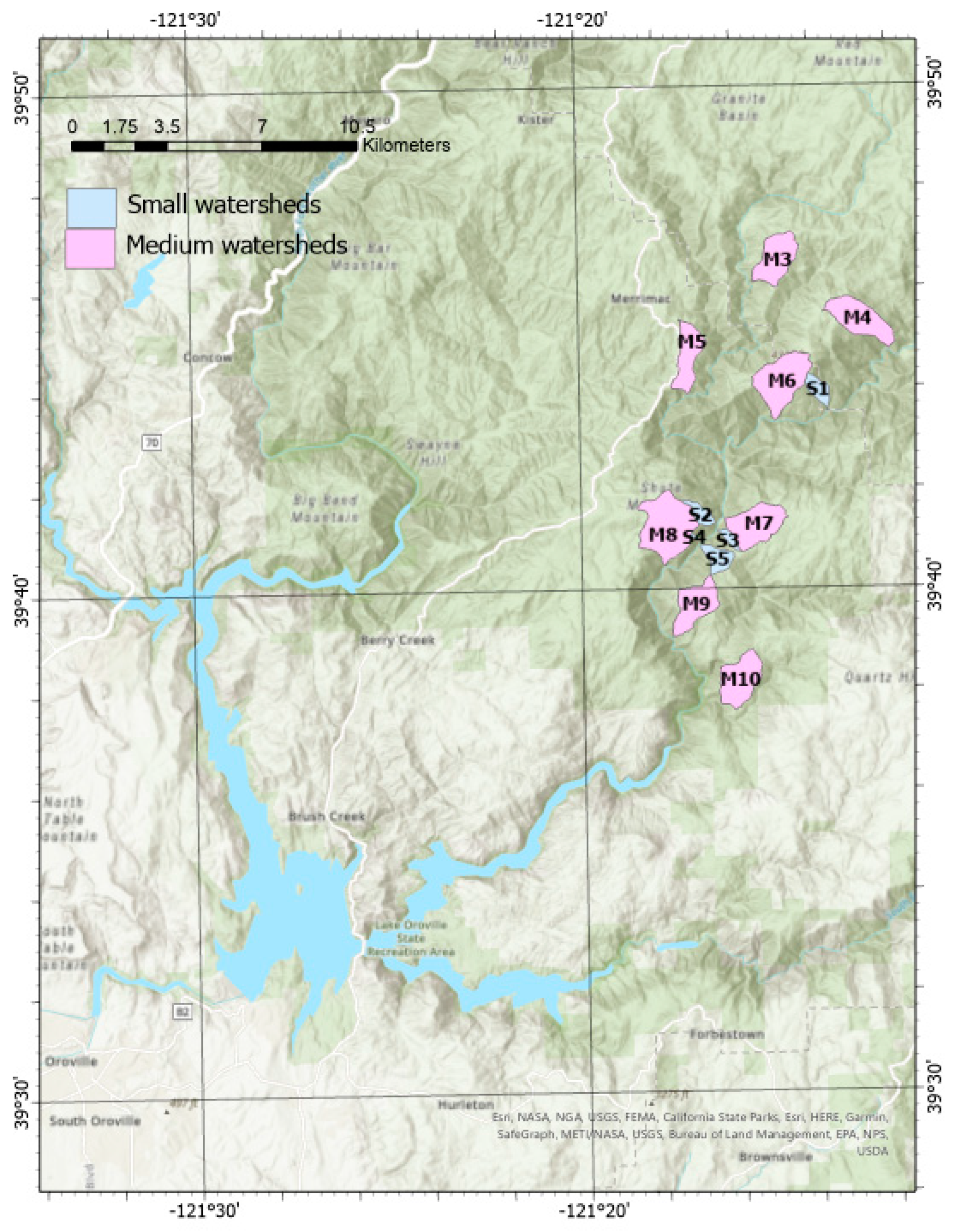



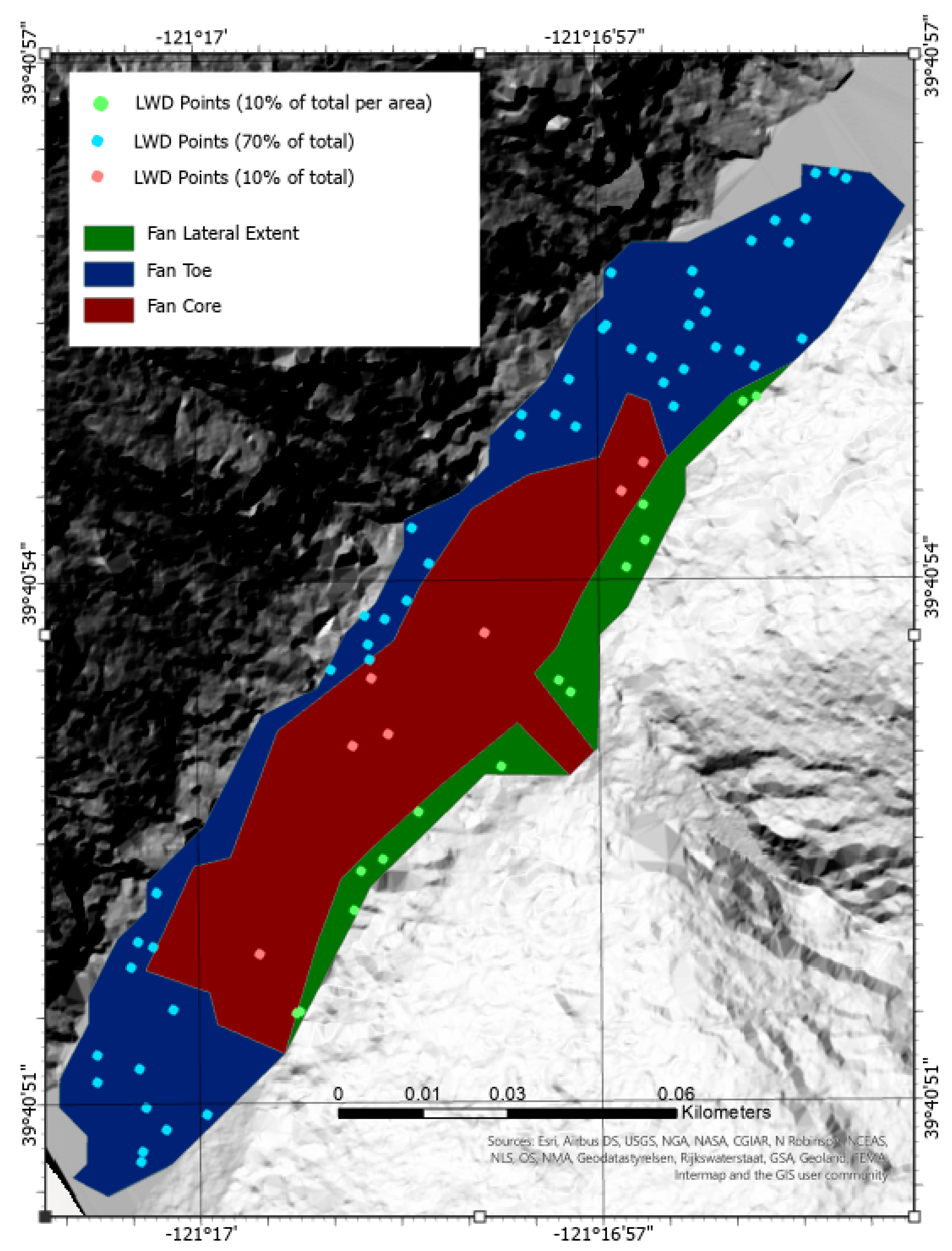

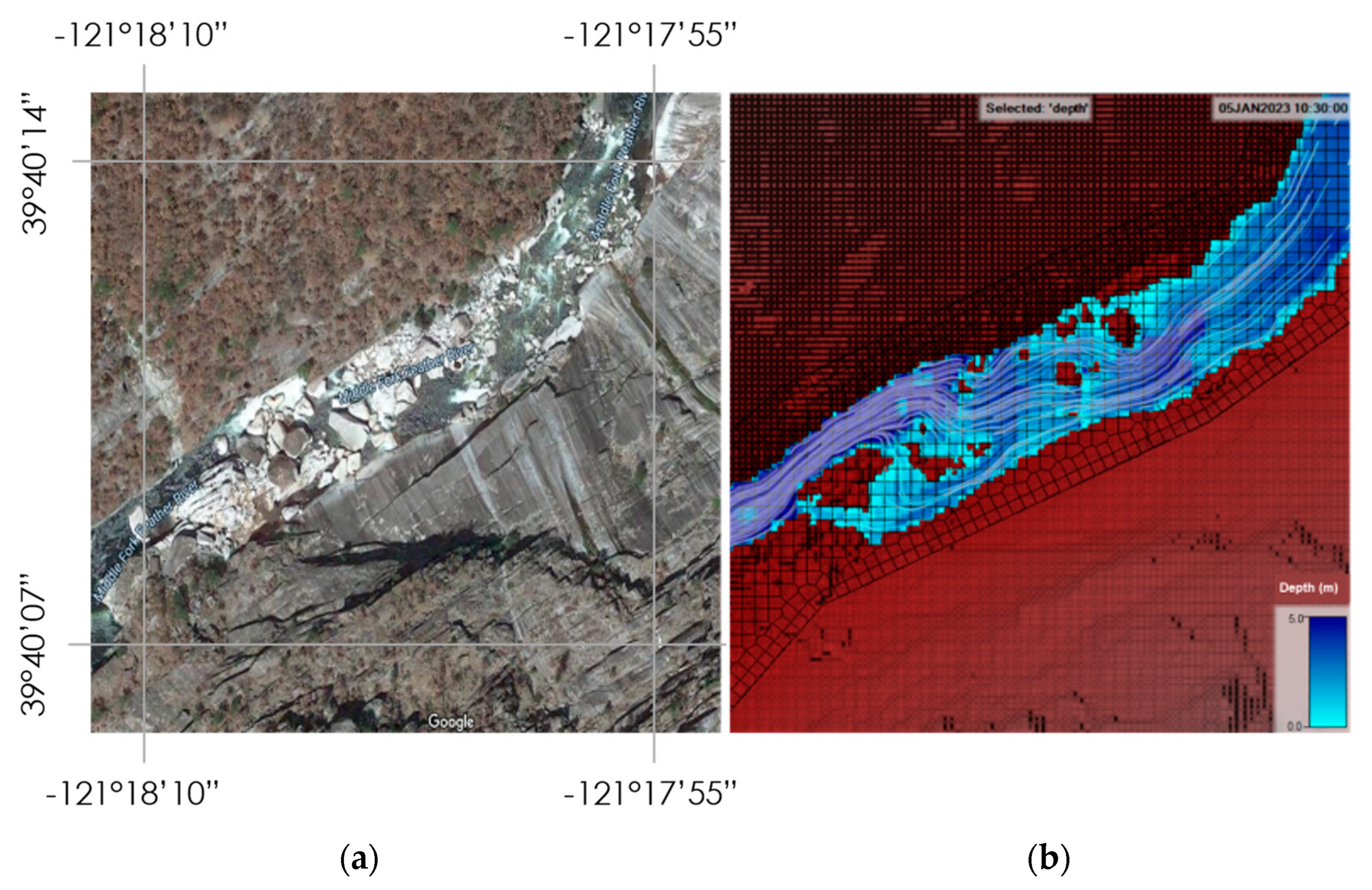
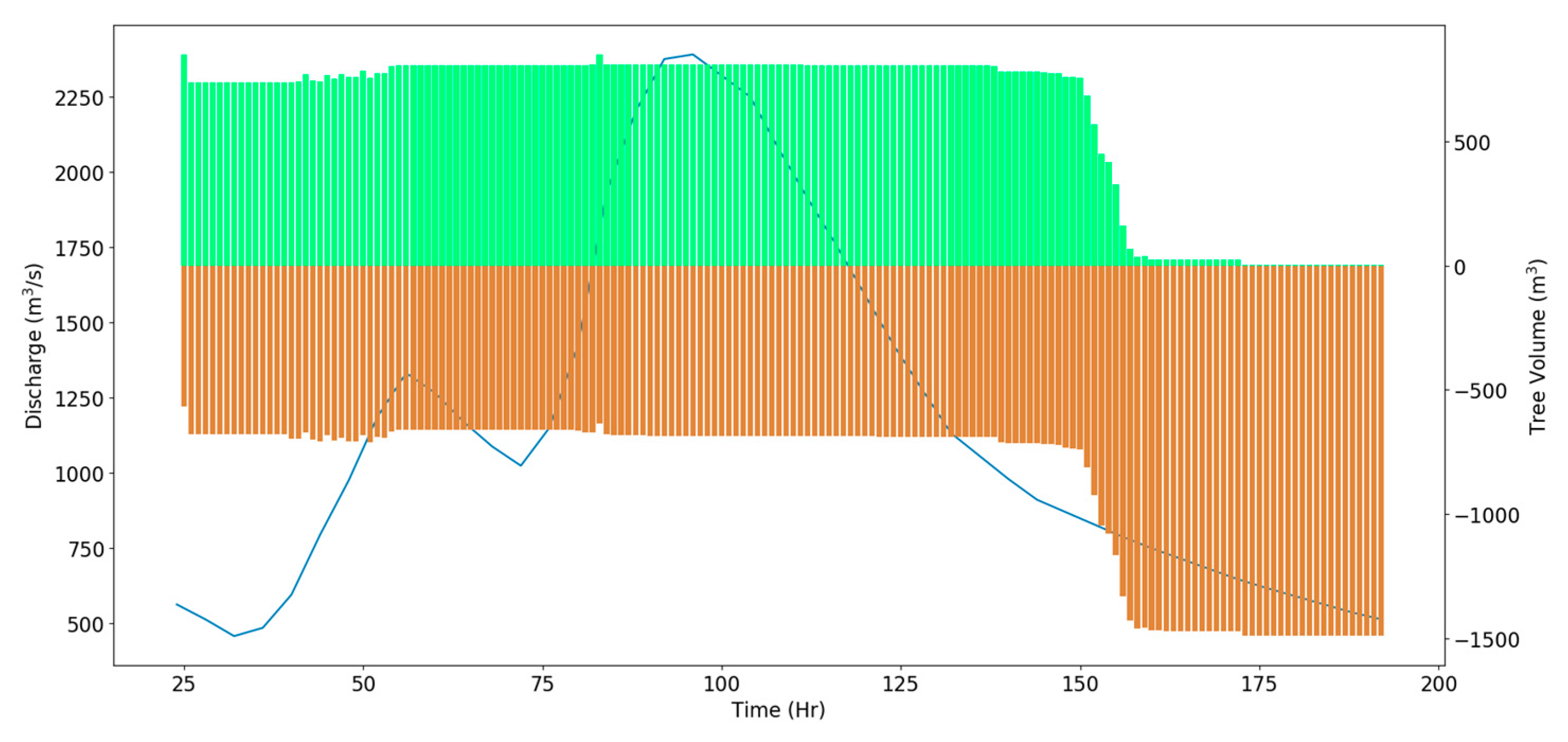
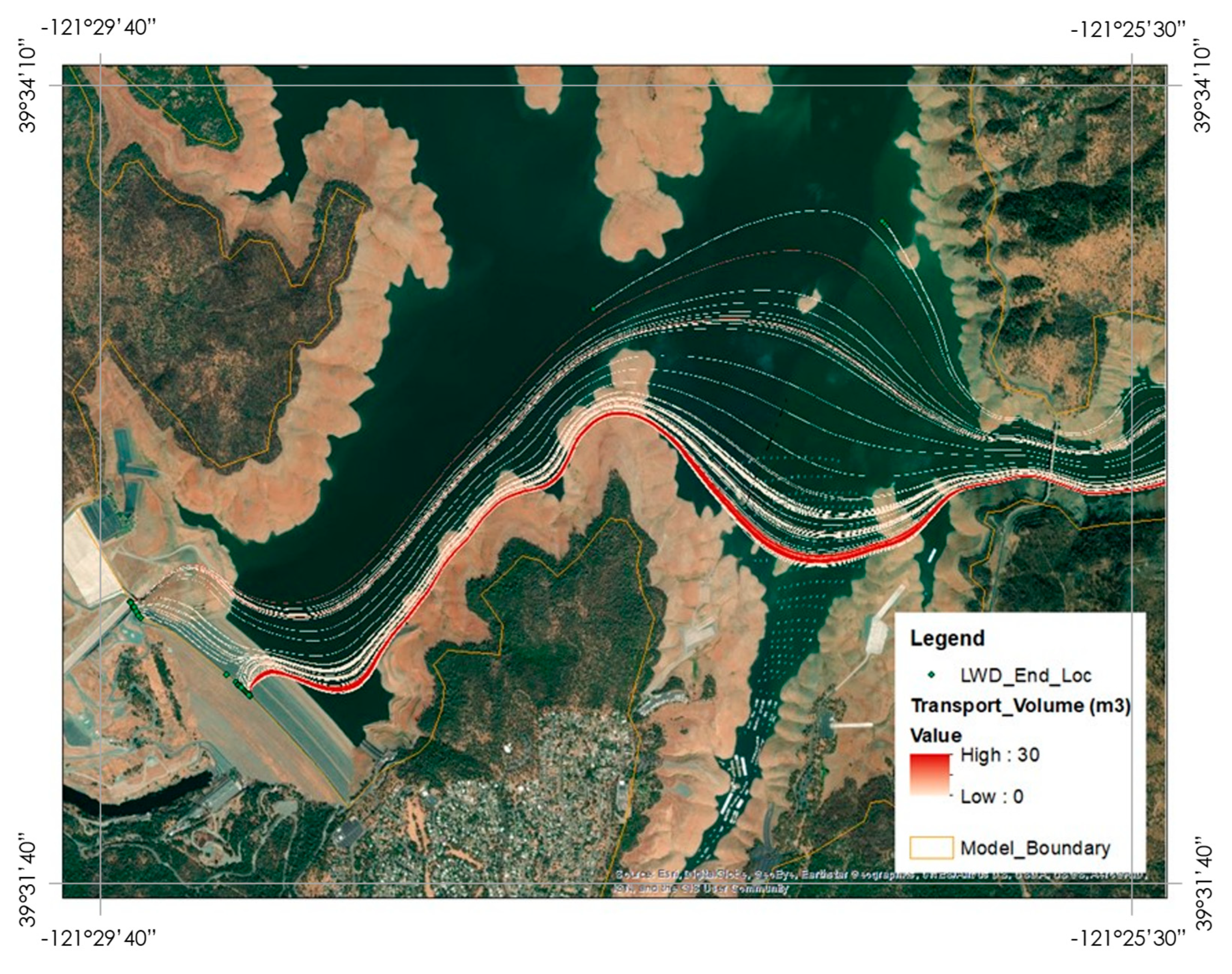
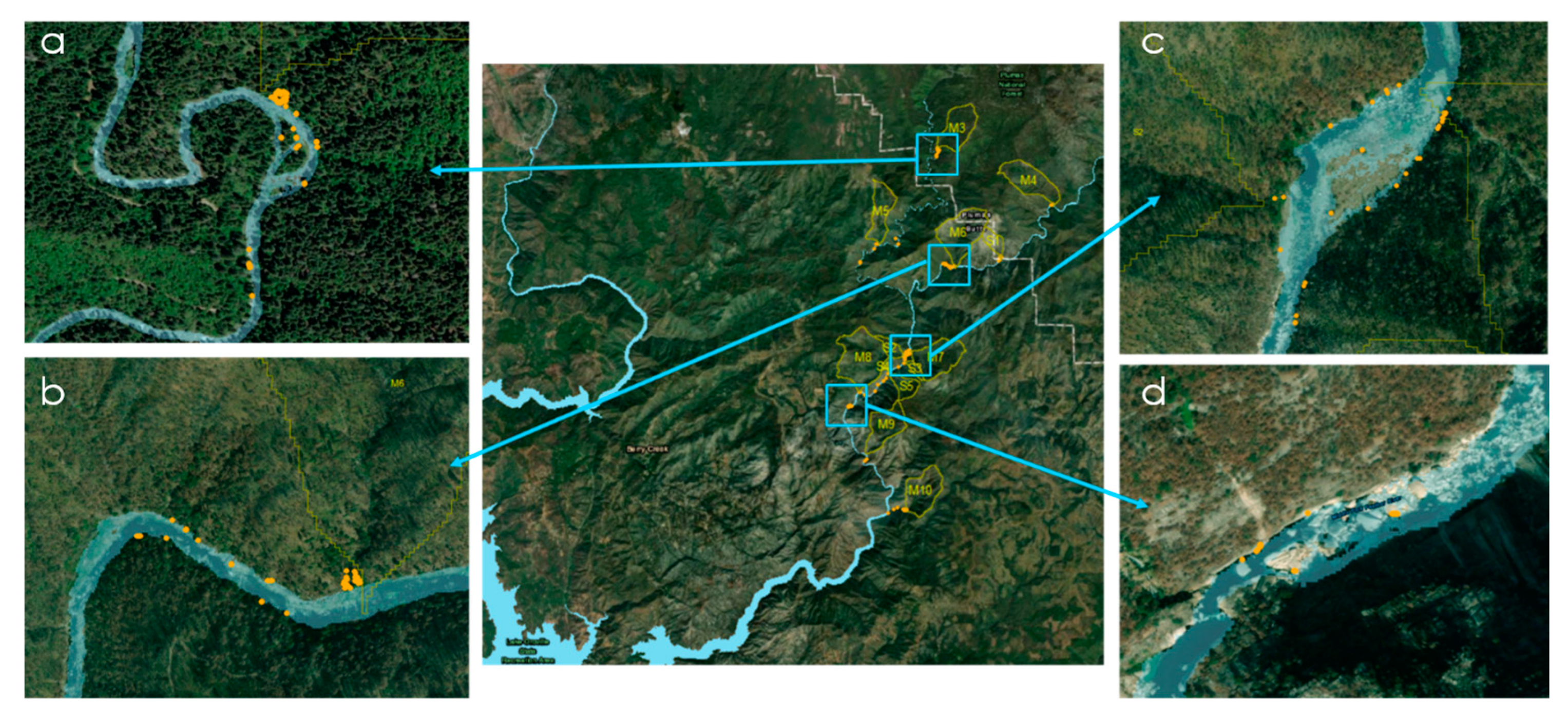
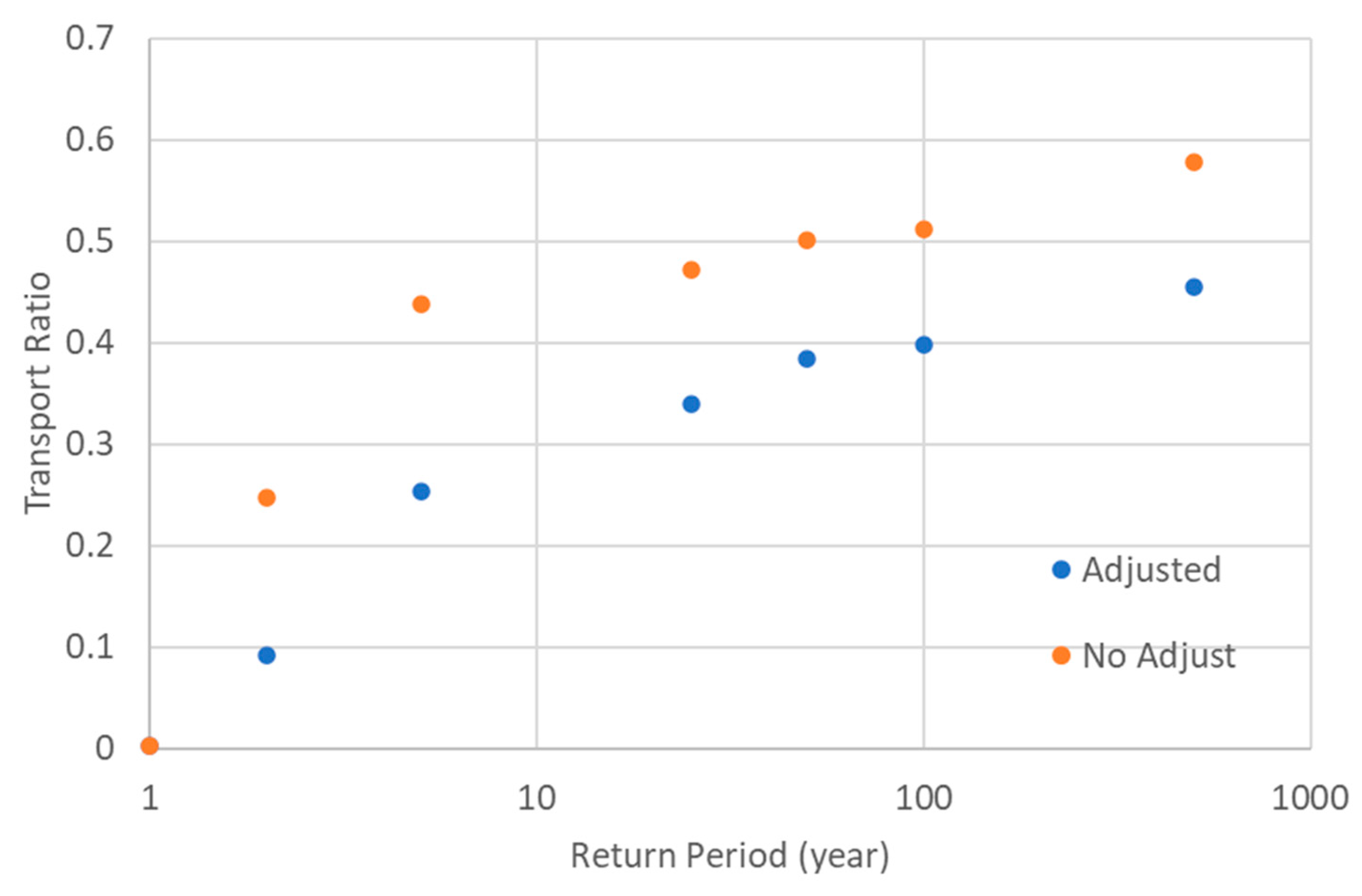
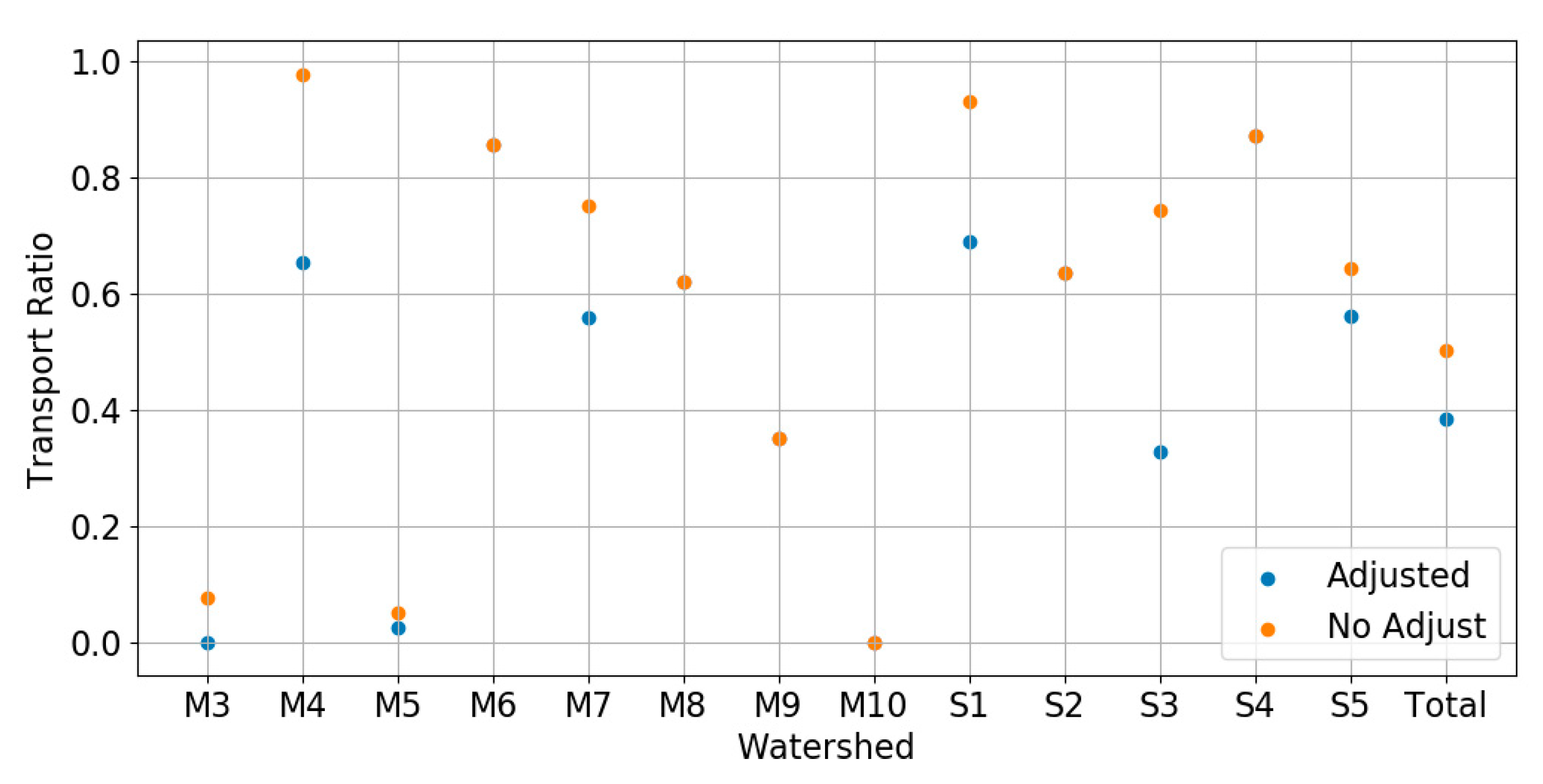
| 15-min Rainfall (mm) | Average Recurrence Interval |
|---|---|
| 8.48 | 1 |
| 10.92 | 2 |
| 14.27 | 5 |
| 17.09 | 10 |
| 21.08 | 25 |
| 24.28 | 50 |
| 27.69 | 100 |
| 31.24 | 200 |
| 36.32 | 500 |
| 40.39 | 1000 |
| Watershed Number | Hectares | LWD Count | LWD Volume (m3) | Debris Flow Volume (m3) |
|---|---|---|---|---|
| M3 | 204.6 | 144 | 517.6 | 9181.4 |
| M4 | 235.7 | 140 | 430.4 | 92,075.4 |
| M5 | 176.1 | 33 | 103.5 | 107,562.6 |
| M6 | 303.0 | 194 | 380.1 | 971,462.7 |
| M7 | 243.5 | 139 | 451.4 | 379,752.3 |
| M8 | 375.5 | 83 | 132.4 | 129,475.8 |
| M9 | 202.0 | 13 | 24.5 | 147,622.5 |
| M10 | 222.7 | 143 | 644.1 | 577,597.5 |
| S1 | 62.2 | 81 | 153.6 | 284,825.7 |
| S2 | 46.6 | 9 | 11.5 | 76,653.0 |
| S3 | 20.7 | 17 | 118.0 | 64,341.0 |
| S4 | 5.2 | 7 | 2.3 | 41,096.7 |
| S5 | 77.7 | 70 | 190.0 | 228,922.2 |
| Total | 2175.6 | 1073 | 3159.4 | 3,110,568.8 |
| Small Sum | 212.4 | 184 | 475.4 | 695,838.6 |
| Medium Sum | 1963.2 | 889 | 2684.0 | 2,414,730.2 |
| Small Mean | 42.5 | 36.8 | 95.1 | 139,167.7 |
| Medium Mean | 245.4 | 111.1 | 355.5 | 301,841.3 |
| Watershed | LWD Volume (m3) | Volume Ratio | Transport Ratio—No Adjustment | ||||||
| 1-Year | 2-Year | 5-Year | 25-Year | 50-Year | 100-Year | 500-Year | |||
| M3 | 264 | 0.16 | 0 | 0 | 0 | 0 | 0.08 | 0 | 0.36 |
| M4 | 219 | 0.14 | 0 | 0.17 | 0.97 | 0.98 | 0.98 | 0.98 | 1 |
| M5 | 53 | 0.03 | 0 | 0 | 0 | 0.06 | 0.05 | 0.33 | 0.56 |
| M6 | 194 | 0.12 | 0 | 0.45 | 0.66 | 0.74 | 0.86 | 0.89 | 0.91 |
| M7 | 230 | 0.14 | 0 | 0.55 | 0.8 | 0.75 | 0.75 | 0.67 | 0.68 |
| M8 | 67 | 0.04 | 0 | 0.6 | 0.55 | 0.62 | 0.62 | 0.67 | 0.67 |
| M9 | 12 | 0.01 | 0.35 | 0.35 | 0.35 | 0.35 | 0.35 | 0.35 | 0.35 |
| M10 | 328 | 0.2 | 0 | 0 | 0 | 0 | 0 | 0 | 0 |
| S1 | 78 | 0.05 | 0 | 0.03 | 0.66 | 0.89 | 0.93 | 0.93 | 0.95 |
| S2 | 6 | 0 | 0 | 0.2 | 0.63 | 0.63 | 0.63 | 0.63 | 0.63 |
| S3 | 60 | 0.04 | 0 | 0.99 | 0.74 | 0.74 | 0.74 | 0.74 | 0.74 |
| S4 | 1 | 0 | 0 | 0.87 | 0.85 | 0.87 | 0.87 | 0.87 | 0.91 |
| S5 | 97 | 0.06 | 0 | 0.39 | 0.4 | 0.63 | 0.64 | 0.8 | 0.81 |
| Total | 1609 | 1 | 0 | 0.25 | 0.44 | 0.47 | 0.5 | 0.51 | 0.58 |
| Watershed | LWD Volume (m3) | Volume Ratio | Transport Ratio—Adjusted | ||||||
| 1-Year | 2-Year | 5-Year | 25-Year | 50-Year | 100-Year | 500-Year | |||
| M3 | 264 | 0.16 | 0 | 0 | 0 | 0 | 0 | 0 | 0.01 |
| M4 | 219 | 0.14 | 0 | 0.05 | 0.45 | 0.46 | 0.65 | 0.65 | 0.8 |
| M5 | 53 | 0.03 | 0 | 0 | 0 | 0.03 | 0.02 | 0.01 | 0.01 |
| M6 | 194 | 0.12 | 0 | 0.24 | 0.48 | 0.74 | 0.86 | 0.89 | 0.91 |
| M7 | 230 | 0.14 | 0 | 0.17 | 0.46 | 0.56 | 0.56 | 0.48 | 0.66 |
| M8 | 67 | 0.04 | 0 | 0.34 | 0.33 | 0.62 | 0.62 | 0.67 | 0.67 |
| M9 | 12 | 0.01 | 0.35 | 0.35 | 0.35 | 0.35 | 0.35 | 0.35 | 0.35 |
| M10 | 328 | 0.2 | 0 | 0 | 0 | 0 | 0 | 0 | 0 |
| S1 | 78 | 0.05 | 0 | 0.03 | 0.28 | 0.65 | 0.69 | 0.69 | 0.95 |
| S2 | 6 | 0 | 0 | 0.2 | 0.63 | 0.63 | 0.63 | 0.63 | 0.63 |
| S3 | 60 | 0.04 | 0 | 0.08 | 0.33 | 0.33 | 0.33 | 0.33 | 0.33 |
| S4 | 1 | 0 | 0 | 0.87 | 0.85 | 0.87 | 0.87 | 0.87 | 0.91 |
| S5 | 97 | 0.06 | 0 | 0.14 | 0.39 | 0.55 | 0.56 | 0.56 | 0.81 |
| Total | 1609 | 1 | 0 | 0.09 | 0.25 | 0.34 | 0.38 | 0.39 | 0.46 |
| Return Period (Years) | LWD Volume (m3) | |
|---|---|---|
| Adjusted | No Adjustment | |
| 1 | 274 | 274 |
| 2 | 8428 | 22,807 |
| 5 | 23,480 | 40,503 |
| 25 | 31,456 | 46,716 |
| 50 | 35,505 | 46,374 |
| 100 | 36,823 | 47,355 |
| 500 | 42,141 | 53,467 |
Disclaimer/Publisher’s Note: The statements, opinions and data contained in all publications are solely those of the individual author(s) and contributor(s) and not of MDPI and/or the editor(s). MDPI and/or the editor(s) disclaim responsibility for any injury to people or property resulting from any ideas, methods, instructions or products referred to in the content. |
© 2023 by the authors. Licensee MDPI, Basel, Switzerland. This article is an open access article distributed under the terms and conditions of the Creative Commons Attribution (CC BY) license (https://creativecommons.org/licenses/by/4.0/).
Share and Cite
Wasklewicz, T.; Chen, A.; Guthrie, R.H. Post-Wildfire Debris Flow and Large Woody Debris Transport Modeling from the North Complex Fire to Lake Oroville. Water 2023, 15, 762. https://doi.org/10.3390/w15040762
Wasklewicz T, Chen A, Guthrie RH. Post-Wildfire Debris Flow and Large Woody Debris Transport Modeling from the North Complex Fire to Lake Oroville. Water. 2023; 15(4):762. https://doi.org/10.3390/w15040762
Chicago/Turabian StyleWasklewicz, Thad, Aaron Chen, and Richard H. Guthrie. 2023. "Post-Wildfire Debris Flow and Large Woody Debris Transport Modeling from the North Complex Fire to Lake Oroville" Water 15, no. 4: 762. https://doi.org/10.3390/w15040762







